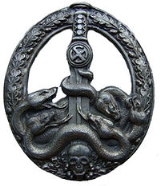
Anti-Partisan Guerrilla Warfare Badge
Encyclopedia
The Anti-Partisan Guerrilla Warfare Badge (German Bandenkampfabzeichen) was an award of the German military of the Third Reich. Personnel of the Heer, Luftwaffe, and Waffen-SS
were eligible to receive it. In German, it was called the "Bandenkampf-Abzeichen", as Reichsfuhrer-SS
Heinrich Himmler
decided to use the term Banden instead of partisans, not wishing to give credence to the guerrillas.
Partisans
or guerrilla fighters were active in almost every country Germany invaded during the Second World War, and while many of these movements were initially small and disorganized, in many cases, they coalesced into larger, more powerful bands of fighters. In some countries, notably Russia
and the Yugoslavia
n states, the partisans became large and dangerous movements, requiring increasing German manpower and resources to resist them. The anti-partisan guerrilla warfare badge was created in recognition of the Axis soldiers involved in these behind-the-lines battles.
The badge existed in three grades, bronze, for 20 combat days, silver, for 50 combat days, and gold, for 100 combat days against partisans. Criteria were slightly different for the Luftwaffe, being based on sorties instead of days in action.
Members of the Wehrmacht avoided wearing it, while the Waffen SS men wore it with pride, claiming it was "their" badge.
Waffen-SS
The Waffen-SS was a multi-ethnic and multi-national military force of the Third Reich. It constituted the armed wing of the Schutzstaffel or SS, an organ of the Nazi Party. The Waffen-SS saw action throughout World War II and grew from three regiments to over 38 divisions, and served alongside...
were eligible to receive it. In German, it was called the "Bandenkampf-Abzeichen", as Reichsfuhrer-SS
Reichsführer-SS
was a special SS rank that existed between the years of 1925 and 1945. Reichsführer-SS was a title from 1925 to 1933 and, after 1934, the highest rank of the German Schutzstaffel .-Definition:...
Heinrich Himmler
Heinrich Himmler
Heinrich Luitpold Himmler was Reichsführer of the SS, a military commander, and a leading member of the Nazi Party. As Chief of the German Police and the Minister of the Interior from 1943, Himmler oversaw all internal and external police and security forces, including the Gestapo...
decided to use the term Banden instead of partisans, not wishing to give credence to the guerrillas.
Partisans
Partisan (military)
A partisan is a member of an irregular military force formed to oppose control of an area by a foreign power or by an army of occupation by some kind of insurgent activity...
or guerrilla fighters were active in almost every country Germany invaded during the Second World War, and while many of these movements were initially small and disorganized, in many cases, they coalesced into larger, more powerful bands of fighters. In some countries, notably Russia
Russia
Russia or , officially known as both Russia and the Russian Federation , is a country in northern Eurasia. It is a federal semi-presidential republic, comprising 83 federal subjects...
and the Yugoslavia
Yugoslavia
Yugoslavia refers to three political entities that existed successively on the western part of the Balkans during most of the 20th century....
n states, the partisans became large and dangerous movements, requiring increasing German manpower and resources to resist them. The anti-partisan guerrilla warfare badge was created in recognition of the Axis soldiers involved in these behind-the-lines battles.
The badge existed in three grades, bronze, for 20 combat days, silver, for 50 combat days, and gold, for 100 combat days against partisans. Criteria were slightly different for the Luftwaffe, being based on sorties instead of days in action.
Members of the Wehrmacht avoided wearing it, while the Waffen SS men wore it with pride, claiming it was "their" badge.
External links
- http://www.wehrmacht-awards.com/war_badges/heer/anti_partisan_badge.htm
- http://www.lexikon-der-wehrmacht.de/Orden/ss-bka.html (in German)

